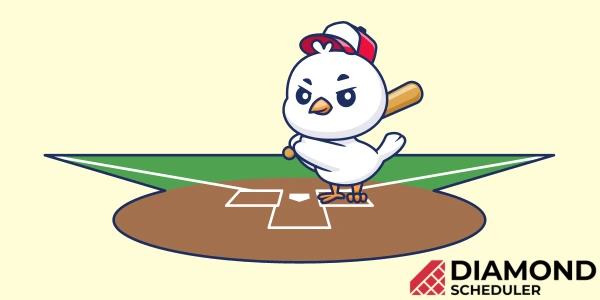
The Owner's Guide to Little League Field Dimensions
Baseball is one of America’s favorite pastimes and has seen continued international growth since its return to the Olympics in 2020.
Baseball’s younger division, Little League, has grown year after year as teams from around the world gather in Williamsport, Pennsylvania, annually to compete for the championship.
With the increased growth comes the opportunity for expansion among league owners and the ability to provide kids with the chance to fulfill their dreams.
Little League fields are an important part of the game for players and spectators.
Field dimensions vary depending on age group, with each field size designed to provide a safe playing environment while allowing for competitive play.
It’s important to know the dimensions of a Little League field for the age groups within your league to ensure that the players have adequate space when playing.
As a league owner, you may also be tasked with setting up a baseball diamond, of which field dimensions and measurements require precision and attention to detail.
In this article, we’ll discuss the different types of Little League field dimensions, the correct parameters, and the recommended safety considerations to help you set up a field from scratch.
What is the playing space for Little Leaguers?

The playing space for Little Leaguers can vary depending on the age group.
As one would expect, as age increases, so will the distance Little Leaguers are able to hit a home run.
That said, the outfield fence will need to be pushed out further to maintain competition in the game.
There’s no established length that must be adhered to, and most times, the local league will determine this number.
There are, however, recommended field specifications set by the Little League.
Below are the steps that you can take to determine the right playing space for your field:
Step 1: Start your measurements from the home plate
When deciding the field playing space, it’s important to start with the distance to the outfield fence.
To do this, you will start your measurement from the point, or the apex, of the home plate.
Step 2: Establish distance based on league division and local league specifics
Following are the recommended distances from the back of the home plate to the outfield fence:
Little League and below: 200 ft
Intermediate (50/70): 200 ft
Junior and Senior League: 300 ft
Step 3: Determine the fence length
The length of the fence, from foul line to foul line, can be determined by multiplying the distance from the home plate to the outfield fence by 1.6.
What are the baseball diamonds and infield sizes?
The baseball diamond and infield dimensions differ the most regarding field size across age groups and leagues.
1. Little League dimensions
For the Little League, it’s a common practice for the distance between base paths to be 60 feet.
2. Local league dimensions
For some local leagues within the Tee Ball division, the distance may be as short as 50 feet.
3. All division dimenisions
For ages 13 years and up, all divisions will choose up to 90 feet.
4. Junior League and local intermediate league dimensions
Junior League and intermediate local leagues will often choose a base path distance between 7o and 75 feet.
What are the correct baseball diamond placements?
In order to get the right parameters for the diamond and to place the second base correctly, a measurement should be made from the home plate apex directly down the middle of the field.
The measurements are listed below with the respective base path distances:
50 feet: 70 feet and 8.5 inches
60 feet: 84 feet and 10.25 inches
70 feet: 99 feet
90 feet: 127 feet and 3.375 inches
These distances will create a symmetrical diamond for each size of the field.
What is the appropriate pitching distance?
The next measurement to make, pitching distance, is crucial for instilling fair competition and safety within the game for youth athletes.
Little League Baseball takes careful consideration for its athletes.
One way to minimize injury is to match the distance from the home plate to the pitching mound with the age groups, skill level, and strength.
Below are the pitching distances:
Little League and below: 46 feet
Junior and Senior League divisions: 60 feet and 6 inches
Local leagues: 54 or 50 feet for junior and intermediate play
How do you determine the infield radius?
Establishing the perimeter where the dirt meets the grass is called the infield radius.
This final measurement, along with the circles around the bases and the pitcher’s mound, completes the infield.
Start your measurements at the pitching mound and measure outwards for the respective base path distances.
50 or 60 feet base paths: 50 feet
70 to 80 feet base paths for Intermediate leagues: 65 to 80 feet
90 feet base paths: 95 feet
Where are the foul territories?

Foul lines are relatively the same across leagues and age groups.
These lines will extend out of the baseball field from the apex of the home base to the back fence.
The foul line will touch the outer parts of the first and third base.
What are the dimensions of dugouts and backstops?
Dugouts are typically situated near the first and third base.
They are located in the foul territories on each side and should be 10 feet long but no longer than 15 feet.
The dugouts should also be covered and fenced to prevent injuries.
Backstops are the fences that are set up behind the home base.
These safety measures prevent overthrows, foul balls, and hits from flying into the stands and injuring bystanders.
Check out this video for more on baseball field dimensions:
What are the safety considerations for Little League fields?
The Little League takes its players’ safety and well-being very seriously and has strict rules in place to follow these standards.
The code emphasizes the value of proper equipment, training, and supervision for all program participants, including players, coaches, and volunteers.
The following are some of the important aspects of the Little League safety code:
All volunteers and officials are subjected to background checks.
Coaches and umpires must receive sufficient training and certification.
Ensure that all players are appropriately outfitted with suitable safety equipment.
Promoting responsible and safe behavior both on and off the field.
Provide instructions on how to use equipment, facilities, and playing fields.
Creating and carrying out emergency action plans in the event of an injury or other emergency.
Instilling sportsmanship and fair play in all players.
Check out this link for a more in-depth look at the Little League's safety guidelines.
Frequently asked questions
What are the standard dimensions of a Little League field?
The base paths for the Little League are generally 60 feet long, while the pitching distance is 46 feet.
The distance from the apex of the home plate to the outfield fence can be determined by the local league but is usually preferred as 200 feet.
Below are the full dimensions:
Length: 200’ | 60.96 m (Fence) Area: 31,485 ft² | 2925 m²
Base Distance: 60’ | 18.3 m
Infield Arc Radius (from pitching rubber): 50’ | 15.2 m
Infield Hypotenuse: 84’ 10-1/4” | 25.9 m
Pitching Rubber Distance: 46’ | 14 m
Mound Distance (Center): 45’ | 13.7 m
Mound Radius: 5’ | 1.5 m
Home Plate Radius: 10’ | 3 m
Base Cutout Radius: 9’ | 2.7 m
Baseline Width: 4’ | 1.2 m
Distance to Backstop: 25’ | 7.6 m
How large is the infield on a Little League field?
The infield is about 2,500 ft in area.
Can I make my own Little League field at home?
Technically, you could if you have enough room, but it would be a costly project and even more expensive to maintain.
Baseball fields require constant maintenance, well-designed irrigation, digital water management to track consumption, or even a water drainage system would do the trick.
You would also need to build a fence and dugout.
Are there any safety regulations for Little League fields?
Yes, the Little League has a safety code implemented and a comprehensive list of player safety resources.
Final thoughts
Little League fields come in various sizes to accommodate different age groups.
Knowing the dimensions of Little League fields is essential for creating a safe and competitive playing environment.
It’s also important to consider safety regulations when designing and building a Little League field.
With this knowledge, you can ensure that all players have adequate space and protection while enjoying their game.
Baseball field availability and capacity can be difficult to work around, especially with the growing number of teams looking to participate in the Little League or other youth baseball programs.
With the help of Diamond Scheduler, you can take on complex schedules and manage your league effortlessly so you can get back to enjoying the game.



